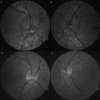Syphilis mimicking idiopathic intracranial hypertension
- PMID: 22674114
- PMCID: PMC3214225
- DOI: 10.1136/bcr.09.2011.4813
Syphilis mimicking idiopathic intracranial hypertension
Abstract
Idiopathic intracranial hypertension (IIH) is a condition of yet unknown aetiology affecting predominantly obese females of childbearing age. IIH is a diagnosis of exclusion as raised cerebrospinal fluid pressure may occur secondary to numerous other medical conditions. An atypical phenotype or an atypical disease course should alert the physician to reevaluate a presumed IIH-diagnosis. The authors report a case of a 32-year-old non-obese male with intracranial hypertension, secondary to a syphilitic central nervous system infection, initially misdiagnosed as being idiopathic. Upon relevant antibiotic treatment, signs and symptoms of elevated intracranial pressure resolved completely. Syphilis is a rare, but very important, differential diagnosis that in this case was clinically indistinguishable from IIH.
Conflict of interest statement
Figures


Similar articles
-
Idiopathic intracranial hypertension: pseudotumor cerebri.Headache. 2014 Feb;54(2):389-93. doi: 10.1111/head.12284. Headache. 2014. PMID: 24512582 Review.
-
Update on the Diagnosis and Treatment of Idiopathic Intracranial Hypertension.Semin Neurol. 2015 Oct;35(5):527-38. doi: 10.1055/s-0035-1563569. Epub 2015 Oct 6. Semin Neurol. 2015. PMID: 26444398 Review.
-
High-pressure headaches: idiopathic intracranial hypertension and its mimics.Nat Rev Neurol. 2012 Dec;8(12):700-10. doi: 10.1038/nrneurol.2012.223. Epub 2012 Nov 20. Nat Rev Neurol. 2012. PMID: 23165338 Review.
-
Idiopathic intracranial hypertension: pseudotumor cerebri.Optometry. 2002 Sep;73(9):546-52. Optometry. 2002. PMID: 12387561 Review.
-
Chronic fatigue syndrome and idiopathic intracranial hypertension: Different manifestations of the same disorder of intracranial pressure?Med Hypotheses. 2017 Aug;105:6-9. doi: 10.1016/j.mehy.2017.06.014. Epub 2017 Jun 24. Med Hypotheses. 2017. PMID: 28735654
Cited by
-
Infectious and inflammatory disorders might increase the risk of developing idiopathic intracranial hypertension - a national case-control study.Cephalalgia. 2020 Sep;40(10):1084-1094. doi: 10.1177/0333102420928079. Epub 2020 May 25. Cephalalgia. 2020. PMID: 32447976 Free PMC article.
-
Antithrombin III deficiency and idiopathic intracranial hypertension: a case report.J Med Case Rep. 2025 Jan 4;19(1):2. doi: 10.1186/s13256-024-04997-z. J Med Case Rep. 2025. PMID: 39755655 Free PMC article.
-
Unusual Primary Ocular Manifestation of Sarcoidosis.Case Rep Ophthalmol. 2019 Jul 3;10(2):205-212. doi: 10.1159/000501302. eCollection 2019 May-Aug. Case Rep Ophthalmol. 2019. PMID: 31692537 Free PMC article.
-
Tumor cerebri: Metastatic renal cell carcinoma with dural venous sinus compression leading to intracranial hypertension; a case report.Surg Neurol Int. 2017 Aug 9;8:175. doi: 10.4103/sni.sni_69_17. eCollection 2017. Surg Neurol Int. 2017. PMID: 28868187 Free PMC article.
-
Bilateral optic disc swelling resulting from lymphocytic meningitis and posterior uveitis secondary to syphilis.BMJ Case Rep. 2021 May 19;14(5):e239813. doi: 10.1136/bcr-2020-239813. BMJ Case Rep. 2021. PMID: 34011659 Free PMC article.
References
-
- Friedman DI, Jacobson DM. Diagnostic criteria for idiopathic intracranial hypertension. Neurology 2002;59:1492–5 - PubMed
-
- Hook EW, 3rd, Marra CM. Acquired syphilis in adults. N Engl J Med 1992;326:1060–9 - PubMed
-
- Marra CM. Update on neurosyphilis. Curr Infect Dis Rep 2009;11:127–34 - PubMed
-
- Chahine LM, Khoriaty RN, Tomford WJ, et al. The changing face of neurosyphilis. Int J Stroke 2011;6:136–43 - PubMed
Publication types
MeSH terms
LinkOut - more resources
Full Text Sources
Medical
